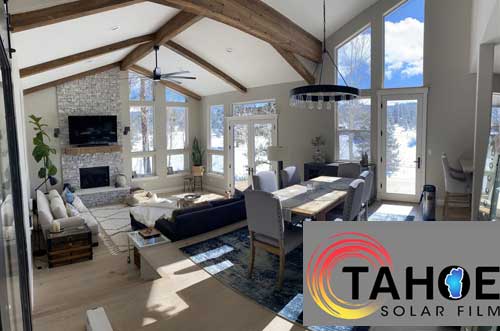When it comes to upgrading your home with window tinting, you may be surprised to learn how many options are available. Window tinting can offer benefits like UV protection, increased privacy, glare reduction, and energy efficiency, but the right type of window film will depend on your needs and preferences. Let’s break down the different types of window tint films available for homes and explain their unique advantages to help you choose the best option for your space.
1. Dyed Window Films
Overview: Dyed window films are among the most common and affordable types of window tinting. These films are made by applying a layer of dye to the adhesive, which then absorbs the sunlight and reduces heat and glare. While these films don’t offer the same level of heat rejection as higher-end options, they are an effective and budget-friendly choice for many homeowners.
Benefits:
- Glare Reduction: Dyed films are excellent at reducing glare, making them ideal for spaces with high levels of direct sunlight.
- Affordable: They are one of the most budget-friendly tinting options available.
- Aesthetic Appeal: Dyed films offer a deep, consistent color that can enhance the look of your windows and improve privacy.
Considerations:
- Heat Rejection: While dyed films reduce some heat, they aren’t as effective at blocking infrared heat compared to more advanced films.
- Durability: Dyed films tend to fade over time, especially if exposed to prolonged sun exposure.
2. Metalized Window Films
Overview: Metalized window films feature a layer of metallic particles that are applied to the film’s surface. These films are highly reflective and are known for their ability to block solar heat and provide excellent glare reduction. Metalized films also add strength to windows by making them more shatter-resistant.
Benefits:
- Heat Rejection: Metalized films are highly effective at reflecting infrared light, keeping your home cooler during hot months.
- UV Protection: These films block up to 99% of UV rays, helping to protect your furniture and flooring from fading.
- Privacy: The reflective nature of metalized films offers excellent daytime privacy by making it harder for people to see inside.
- Durability: Metalized films tend to be more durable than dyed films, and they do not fade as quickly.
Considerations:
- Signal Interference: The metallic layer can interfere with radio, cell phone, and Wi-Fi signals. If you rely on these signals in your home, you might want to avoid this option.
- Aesthetic: Some homeowners don’t like the mirrored or shiny appearance of metalized films, which can alter the appearance of the home’s windows.
3. Ceramic Window Films
Overview: Ceramic window films are made from ceramic particles, which offer the best of both worlds: high heat rejection without the reflective appearance. Unlike metalized films, ceramic films are non-metallic and don’t interfere with signals, making them a popular choice for those who want the performance of a high-end film with the added benefit of clarity and visibility.
Benefits:
- Superior Heat Rejection: Ceramic films provide excellent solar heat rejection without darkening the windows or affecting natural light.
- UV Protection: Ceramic films block up to 99% of UV rays, helping to protect your interior from sun damage.
- Non-Reflective: These films provide a clear view, which is ideal for homeowners who want privacy without altering the appearance of their windows.
- Signal-Friendly: Since ceramic films are non-metallic, they do not interfere with cellular, Wi-Fi, or radio signals.
Considerations:
- Cost: Ceramic films are generally more expensive than dyed or metalized films. However, the investment can pay off in terms of durability and long-term performance.
- Aesthetic: While clear and non-reflective, ceramic films tend to have a slightly darker tint compared to dyed films, which might not be ideal for every aesthetic.
4. Hybrid Window Films
Overview: Hybrid window films combine the benefits of both dyed and metalized films. These films use a combination of metallic and dyed layers to enhance their performance. Hybrid films are designed to offer the heat rejection benefits of metalized films while avoiding the signal interference issues.
Benefits:
- Heat Rejection: Hybrid films offer improved heat rejection, keeping your home cooler in the summer months.
- Glare Reduction: Like dyed films, hybrid films help reduce glare, making your home more comfortable.
- UV Protection: Hybrid films block UV rays and help prevent your furniture, flooring, and artwork from fading.
- Signal-Friendly: Unlike fully metalized films, hybrid films do not interfere with signals, making them ideal for homes with wireless devices.
Considerations:
- Cost: Hybrid films are more expensive than dyed films but less costly than ceramic films.
- Aesthetic: The appearance of hybrid films can vary depending on the combination of dyed and metalized layers. It may not be as consistent in look as dyed films.
5. Low-E (Low Emissivity) Films
Overview: Low-E films are designed to provide year-round energy efficiency by reflecting both heat and UV rays. These films have a special coating that reflects heat back into the room during the winter while blocking solar heat during the summer. Low-E films are particularly beneficial for homes that experience extreme temperature fluctuations.
Benefits:
- Energy Efficiency: Low-E films are highly effective at reducing heating and cooling costs by reflecting heat in both hot and cold weather.
- UV Protection: They block up to 99% of harmful UV rays.
- Comfort: These films help maintain a more consistent indoor temperature, making your home more comfortable year-round.
- Invisible Coating: Low-E films are typically clear, so they won’t drastically change the appearance of your windows.
Considerations:
- Cost: Low-E films are often among the more expensive window tinting options due to their energy-efficient properties.
- Specialized Use: Best suited for homes in climates that experience both extreme heat and cold temperatures.
6. Frosted and Decorative Window Films
Overview: Frosted and decorative films are typically used for enhancing privacy rather than energy efficiency. These films provide a frosted or etched appearance, making them ideal for bathrooms, home offices, or any space where privacy is a concern. They also offer a stylish design element to your windows.
Benefits:
- Privacy: Frosted and decorative films offer excellent privacy without completely blocking light.
- Aesthetic Appeal: These films can add a modern or elegant touch to any room, giving it a more sophisticated look.
- Light Diffusion: Frosted films soften natural light, reducing glare while still allowing light to flow through the room.
Considerations:
- Limited Heat Rejection: These films are not designed for heat rejection or UV protection and are mainly used for aesthetic and privacy purposes.
- Decorative Use: These films are better for adding a design element rather than providing energy-saving benefits.
Conclusion
When selecting the right window film for your home, it’s important to consider both the functional and aesthetic needs of your space. Whether you’re looking for superior heat rejection, UV protection, or enhanced privacy, there’s a window film option that can help improve your home’s comfort and appearance.
- For superior heat and UV protection: Ceramic and Low-E films are excellent choices.
- For privacy and glare reduction: Dyed, metalized, or hybrid films offer the best results.
- For added design flair: Frosted and decorative films can give your home a modern, stylish look while maintaining privacy.
Consult with a professional window tinting company, like Tahoe Solar Film, to help you choose the best window film based on your home’s needs and style preferences.

